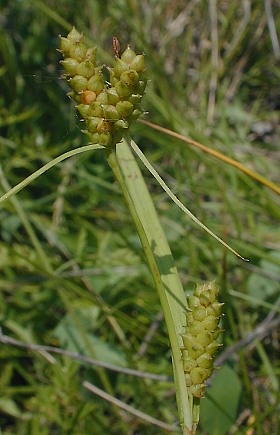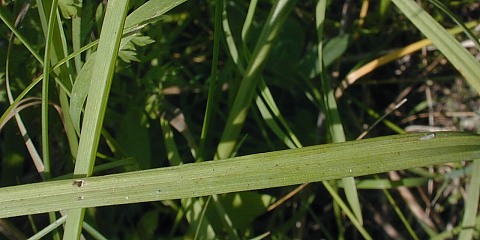Description:
This
perennial sedge produces non-flowering tufts of leaves and
flowering culms about ¾–2' tall. The narrow culms are unbranched,
hairless, and round to 3-angled in cross-section. There are up to 5
alternate leaves along each culm. The linear leaves are up to 1/3" (8
mm.)
across and 12" long. They are light green to blue-green, hairless,
slightly rough (scabrous) along the margins, and occasionally slightly
glaucous. Each culm produces 1-2 axillary spikelets of pistillate flowers, 1-2 terminal spikelets of pistillate flowers, and a single
terminal spikelet of staminate flowers. The staminate spikelet is
nearly sessile to short-stalked and up to 1½" long. It becomes
brown and
shriveled-looking shortly after releasing its pollen. The pistillate
spikelets are up to 1¼" long, about 1/5" (5 mm.) across, and
short-cylindrical
in shape. They have a grainy appearance because of the densely crowded
perigynia of the pistillate flowers. Each perigynium is about 3 mm.
long and 2 mm. across; it is broadly ovoid to slightly obovoid and
hairless, tapering to a short beak. Several longitudinal veins run
along its sides that are usually conspicuous. The color of each
perigynium varies from light green to yellowish brown, depending on its
maturity; sometimes it has fine red speckles. Underneath each
peryigynium is a short pistillate scale that abruptly tapers to a short
narrow tip; this scale is usually shorter than the perigynium and
inconspicuous. The axillary pistillate spikelets are short- to
long-stalked, while the terminal pistillate spikelets are sessile to
short-stalked. Underneath each terminal spikelet of pistillate flowers,
there is a slender leafy bract that is longer than the spikelet. The
blooming period occurs during the late spring to early summer and lasts
about 1-2 weeks. Pollination occurs by agency of the wind. Afterwards,
the pistillate spikelets persist for about a month as their achenes
develop. These achenes are about 1.8 mm. in length, obovoid in shape,
and 3-angled. The root system consists of short rhizomes and coarse
fibrous roots. Tight tufts of leaves are often formed from the short
rhizomes.
flowers, 1-2 terminal spikelets of pistillate flowers, and a single
terminal spikelet of staminate flowers. The staminate spikelet is
nearly sessile to short-stalked and up to 1½" long. It becomes
brown and
shriveled-looking shortly after releasing its pollen. The pistillate
spikelets are up to 1¼" long, about 1/5" (5 mm.) across, and
short-cylindrical
in shape. They have a grainy appearance because of the densely crowded
perigynia of the pistillate flowers. Each perigynium is about 3 mm.
long and 2 mm. across; it is broadly ovoid to slightly obovoid and
hairless, tapering to a short beak. Several longitudinal veins run
along its sides that are usually conspicuous. The color of each
perigynium varies from light green to yellowish brown, depending on its
maturity; sometimes it has fine red speckles. Underneath each
peryigynium is a short pistillate scale that abruptly tapers to a short
narrow tip; this scale is usually shorter than the perigynium and
inconspicuous. The axillary pistillate spikelets are short- to
long-stalked, while the terminal pistillate spikelets are sessile to
short-stalked. Underneath each terminal spikelet of pistillate flowers,
there is a slender leafy bract that is longer than the spikelet. The
blooming period occurs during the late spring to early summer and lasts
about 1-2 weeks. Pollination occurs by agency of the wind. Afterwards,
the pistillate spikelets persist for about a month as their achenes
develop. These achenes are about 1.8 mm. in length, obovoid in shape,
and 3-angled. The root system consists of short rhizomes and coarse
fibrous roots. Tight tufts of leaves are often formed from the short
rhizomes.
Cultivation:
The
preference is full to partial sun, wet to mesic conditions, and a loam
or clay-loam soil. This species also tolerates rocky or gravelly soil
that is somewhat alkaline.
Range & Habitat:
Meadow Sedge is occasional to locally common in most areas of Illinois;
it tends to be less common or absent in the southern and western areas
of the state (see Distribution
Map). Habitats include openings in woodlands, swamps,
riverbottom prairies, moist dolomite prairies, weedy meadows, fens and
seeps, moist depressions in limestone cliffs, and abandoned fields.
This species occurs in both disturbed areas and higher quality habitats.
Faunal Associations:
The caterpillars of various butterflies, skippers, and moths feed on Carex
spp. (primarily the foliage). See the Lepidoptera
Table for a listing of these species. Other insects feeding
on Carex spp. include Stethophyma lineata
(Striped Sedge Grasshopper), Stethophyma celata
(Otte's Sedge Grasshopper), and various leafhoppers: Cosmotettix
lineatus, Cosmotettix luteocephalus, Cosmotettix
bierni, and Elymana inornata. The seeds
of Carex spp. are a significant source of food for
upland gamebirds, waterfowl, and songbirds (see the Bird
Table for a listing of these species). The foliage of Carex
spp. is not preferred as a source of food by deer and
rabbits, although livestock will eat it.

Photographic
Location:
A moist weedy meadow along a drainage ditch at Judge Webber Park in
Urbana, Illinois.
Comments:
Meadow Sedge can be distinguished from other Carex spp.
(Sedges) by the grainy appearance of its pistillate spikelets, the
presence of both axillary and terminal pistillate spikelets, and the
presence of a single staminate spikelet on a short terminal stalk.
Other sedges with a similar appearance tend to have pistillate scales
that are longer and more conspicuous.